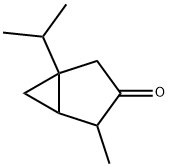THUJONE
- CAS NO.:471-15-8
- Empirical Formula: C10H16O
- Molecular Weight: 152.23
- MDL number: MFCD00135597
- SAFETY DATA SHEET (SDS)
- Update Date: 2024-06-28 13:52:33

What is THUJONE?
Chemical properties
Powerful and penetrating, warm-herbaceous, the minty-camphoraceous odour of moderate to poor tenacity. Warm-herbaceous, bitter taste in concentrations lower than 10 ppm. Higher concentrations produce a pungent-bitter, herbaceous taste.
The Uses of THUJONE
β-Thujone is a component of the essential oil of Pistacia vera L. It is also used as as a reactant in organic synthesis.
Definition
ChEBI: (+)-beta-thujone is a beta-thujone. It is an enantiomer of a (-)-beta-thujone.
Definition
The monoterpenoid ketone Thujone is used sparingly in certain perfume formulations, often as a trace component of topnote compositions, and it blends very well with Oakmoss, Rosemary, Geranium, Galbanum and various green-herbaceous notes, and with certain Ambre-t ype fragrances. Herbs containing essential oils in which Thujone forms a major component have been under suspicion by the food authorities, and many products containing Thujone-beaning oils or extracts have been banned from food, beverages, etc. The toxicity of Thujone is roughly estimated at three times that of Nitrobenzene. However, it is not possible to compare the two since the effect of Thujone is entirely different, sometimes classified as “Curare-like” or paralyzing on the human CNS or heart system. The Thujone content of certain Artemisia species, used in “Absinth” alcoholic beverages, was responsible for banning certain brands of alcoholic beverages in the 1930s in France. Thujone is by some authorities considered the most toxic of all commonly occurring components of essential oils. Thujone is produced by isolation from various essential oils: Cedarleaf oil (Thuja oil), Tansy oil, Dalmatian Sage oil, etc.
Properties of THUJONE
| Melting point: | 170 °C |
| alpha | D15 +72.5° |
| Boiling point: | 84-86 °C17 mm Hg(lit.) |
| Density | 0.925 g/mL at 25 °C(lit.) |
| refractive index | n |
| Flash point: | 148 °F |
| storage temp. | 2-8°C |
| solubility | Practically insoluble in water, soluble in alcohol and oils. |
| form | Almost colourless mobile liquid |
| Odor | herbal warm |
| Dielectric constant | 10.0(0℃) |
Safety information for THUJONE
Computed Descriptors for THUJONE
New Products
4-Fluorophenylacetic acid 4-Methylphenylacetic acid N-Boc-D-alaninol N-BOC-D/L-ALANINOL Tert-butyl bis(2-chloroethyl)carbamate 3-Morpholino-1-(4-nitrophenyl)-5,6-dihydropyridin- 2(1H)-one Furan-2,5-Dicarboxylic Acid Tropic acid S-2-CHLORO PROPIONIC ACID ETHYL ISOCYANOACETATE 2-Bromo-1,3-Bis(Dimethylamino)Trimethinium Hexafluorophosphate (6-METHYL-[1,3]DITHIOLO[4,5-b]QUINOXALIN-2-ONE INDAZOLE-3-CARBOXYLIC ACID 4-IODO BENZOIC ACID (2-Hydroxyphenyl)acetonitrile 4-Bromopyrazole 5,6-Dimethoxyindanone 2-(Cyanocyclohexyl)acetic acid 4-methoxy-3,5-dinitropyridine 2-aminopropyl benzoate hydrochloride 1-(4-(aminomethyl)benzyl)urea hydrochloride diethyl 2-(2-((tertbutoxycarbonyl)amino) ethyl)malonate tert-butyl 4- (ureidomethyl)benzylcarbamate Ethyl-2-chloro((4-methoxyphenyl)hydrazono)acetateRelated products of tetrahydrofuran








You may like
-
 2033-24-1 98%View Details
2033-24-1 98%View Details
2033-24-1 -
 42831-50-5 5-METHYLISOXAZOLE-4-CARBOXYLIC ACID 98%View Details
42831-50-5 5-METHYLISOXAZOLE-4-CARBOXYLIC ACID 98%View Details
42831-50-5 -
 1975-50-4 98%View Details
1975-50-4 98%View Details
1975-50-4 -
 2-HYDROXY BENZYL ALCOHOL 98%View Details
2-HYDROXY BENZYL ALCOHOL 98%View Details
90-01-7 -
 2-Chloro-1,3-Bis(Dimethylamino)Trimethinium Hexafluorophosphate 221615-75-4 98%View Details
2-Chloro-1,3-Bis(Dimethylamino)Trimethinium Hexafluorophosphate 221615-75-4 98%View Details
221615-75-4 -
 61397-56-6 CIS BROMO BENZOATE 98%View Details
61397-56-6 CIS BROMO BENZOATE 98%View Details
61397-56-6 -
 14714-50-2 (2-Hydroxyphenyl)acetonitrile 98+View Details
14714-50-2 (2-Hydroxyphenyl)acetonitrile 98+View Details
14714-50-2 -
 118753-70-1 98+View Details
118753-70-1 98+View Details
118753-70-1